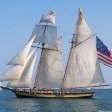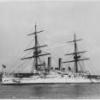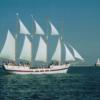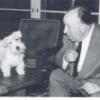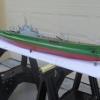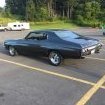MORE HANDBOOKS ARE ON THEIR WAY! We will let you know when they get here.
×
-
Posts
1,871 -
Joined
-
Last visited
Reputation Activity
-
 MEDDO reacted to marsalv in Pandora by marsalv - FINISHED - 1:52
MEDDO reacted to marsalv in Pandora by marsalv - FINISHED - 1:52
Thank you very much guys.
Denis - the red frame in front of the stove is called riding bitts. Citation from the Peter Goodwin´s book The Construction and Fitting of English Man of War:
These large timbers acted as securing point for cables which held the ship while riding at anchor. And why is the stove so close to the riding bitts - I have no idea.
Some new parts - ladders.
-
 MEDDO got a reaction from piter56 in Halifax 1768 by MEDDO - FINISHED - Lauck Street Shipyard - 1/4" scale
MEDDO got a reaction from piter56 in Halifax 1768 by MEDDO - FINISHED - Lauck Street Shipyard - 1/4" scale
So I have been away for a while. My practice went through a massive expansion/contraction/expansion etc etc. Ended up working way too much. I also got somewhat distracted for the last few months building a kayak. I am finishing that up and am cleaning up the shipyard so I can start working again. Here is a picture of where I am now.
I like the new site design and wanted to see if I remembered how to get pictures uploaded etc.
-
 MEDDO got a reaction from RGL in Halifax 1768 by MEDDO - FINISHED - Lauck Street Shipyard - 1/4" scale
MEDDO got a reaction from RGL in Halifax 1768 by MEDDO - FINISHED - Lauck Street Shipyard - 1/4" scale
I been able to get a few more steps done.
Catheads. Weird the instructions only had a single layer for the catheads. Every picture and the plans had these double thick so I had to freehand cut out 2 more then drill the sheave holes in them. They seem to have come out fairly well.
Caprails to cover the frame ends.
Railing supports. These were pretty hard to fit as the pre-drilled/milled holes they fit into in the cap rail were way too small. I didn't notice this until the cap rails were already installed. This made opening them up very difficult. After a bunch of micro scalpel work they sit in pretty well.
Railings. These were 2 layers. The first layer had holes in it to attach to the posts. A top finish layer was then glued on top of it to make a smooth run down the rail.
Here is the state of the build with a few pieces of deck furniture dry fitted on.
-
 MEDDO got a reaction from Blue Ensign in HMS Pegasus by Blue Ensign - FINISHED - Amati/Victory Models - 1:64 scale
MEDDO got a reaction from Blue Ensign in HMS Pegasus by Blue Ensign - FINISHED - Amati/Victory Models - 1:64 scale
Thank you for all the references. And thank you for completing and allowing us to follow along with such a wonderful log.
-
 MEDDO reacted to Tigersteve in 18th Century Longboat by Tigersteve - FINISHED - Model Shipways
MEDDO reacted to Tigersteve in 18th Century Longboat by Tigersteve - FINISHED - Model Shipways
The length of rope for the jibsail halyard was taken from the rigging plan and placed in a rope coil on the floorboards, aft the windlass. This coil was seized with light colored rope.
A gasket coil was created next from the remaining line on the gaff. Included is a reference photo of this type of coil.
The remaining line on the boom was placed in a coil on the aft platform. When these steps were complete, the remaining staging could take place and a final rope coil could be created for the remaining lanyard at the stern. Lashing the boat is next.
Steve
-
 MEDDO reacted to Blue Ensign in HMS Pegasus by Blue Ensign - FINISHED - Amati/Victory Models - 1:64 scale
MEDDO reacted to Blue Ensign in HMS Pegasus by Blue Ensign - FINISHED - Amati/Victory Models - 1:64 scale
Thoughts about Pegasus
This post concludes my build of seven years, and one I have thoroughly enjoyed, as I have enjoyed sharing this journey with my fellow modellers on MSW.
The beauty of this model is that it is large enough for detail but not so big that it raises any serious display issues. It is also highly decorative and is placed in the period before the Nelson chequer and austerity removed much of the decoration from Georgian ships.
Victory models are the ‘posh’ end of Amati a bit like Lexus and Toyota, and the basic kit produces an attractive model of this pretty bijou Frigate.
Thanks are due to Chris Watton who designed the kit, and to Amati who produced it. Even so, most commercial kit manufacturers make simplifications to extend the appeal to a greater range of modeller ability, and include somewhat out of scale and generic fittings and Amati is no exception.
Much of the enjoyment for me has been in enhancing the kit by use of different materials and fittings and bashing it about a bit with a fair amount of scratch building.
Apart from the basic skeleton and some of the brass etch, very little of the kit provided material and fittings have been used, and I am quick to gloss over the additional costs involved.
Outside sourced materials and fittings.
Boxwood strips and section
http://www.originalmarquetry.co.uk/product_details_335.htm
Rigging blocks and associated attachments
https://www.syrenshipmodelcompany.com/
http://www.model-dockyard.com/
Rigging line.
https://www.syrenshipmodelcompany.com/
http://home.foni.net/~agondesen/left.htm
Guns
http://www.rbmodel.com/index.php?action=products&group=023
Anchors
http://www.jotika-ltd.com/Pages/1024768/Fitting_Front.htm
lantern
https://www.syrenshipmodelcompany.com/
Dowels- Ramin for lower masts
Various suppliers - check online
Additional brass etch.
http://www.jotika-ltd.com/Pages/1024768/Fitting_Front.htm
Scratched modifications
Stern Gallery style and decoration.
Great Cabin interior.
Beneath the Foc'sle deck.
Foc'sle rail and belfry.
Quarterdeck rails.
Head works and Cat heads.
Capstans, Gallows, and pumps.
Hatch Coamings
Swivel gun posts.
Masts and yards.
Scratched additions
Galley Stove, Galley Chimney.
Binnacle, Steering stanchions, and Tiller.
Rudder head Cover, Rudder coat.
Clerestory Style Companion top.
Hatch railings, Gang planks, Fish Davit.
Pinnace and Long Boat.
Swinging Booms, Flag staffs and Ensigns.
Reference Works.
For references I primarily used Steel and the Fully Framed book series by David Antscherl, cross referred to Lees, and Marquardt.
Particularly in relation to Masting and Rigging I used Steel to work out the dimensions and line sizes.
http://www.hnsa.org/resources/manuals-documents/age-of-sail/the-elements-and-practice-of-rigging-and-seamanship/
I am quite pleased with the end result of my build and there are only a couple of things I would have done differently were I starting now.
1) I would have reduced the width of the first(Bridle) port to make it narrower than a standard gun port.
2) I would have included the bands of top and butt deck planking on the upper deck.
I would also hope to improve the finish in some of the areas where my knowledge exceeds my skill to carry it out.
I will finally post some completion photo's in the next few days.
Thank you all for following along.
Blue Ensign
8th April 2017.
-
 MEDDO got a reaction from coxswain in 18th Century Longboat by Tigersteve - FINISHED - Model Shipways
MEDDO got a reaction from coxswain in 18th Century Longboat by Tigersteve - FINISHED - Model Shipways
I really like this idea for a stand/presentation.
-
 MEDDO reacted to xken in USS Constitution by xken - Model Shipways - Scale 1:76.8
MEDDO reacted to xken in USS Constitution by xken - Model Shipways - Scale 1:76.8
Well I finished up the ratlines and futtocks for all the masts. Also had to take a break and do some fence repair and garden works with the admiral since she wanted to paint the fence. Since she wanted to paint it; who am I to get in her way so the repair work came first.
I started with the main mast stay lines by first making the mice to fit the served lines. I have serving lines down pat with my Sherline lathe and served six inch lengths and 2 inch lengths on the shroud lines. After forming the loops and locating the mice I added the bull-eyes to the bow and added the cross brace to keep them aligned.
Once the lines were in place I tried tying the snake lines using different weights of threads and the knots at the shrouds just did not look right. So I fell back on my airplane building and took a length of Syren's .008" black line and soaked the line hanging with a weight to stretch and keep straight with a mixture of white glue and water. I soaked the line twice and allowed to dry overnight which resulted in a nice stiff line to work with. The sequence of pictures will explain better than words. Also having tied over 2,000 clove hitches was great preparation for tying the snake line in place. This does require knowing how to tie a clove hitch upside down and backwards given some of the locations around the foremast. With black thread, black snake line on black shrouds will also test one's depth perception.
Now to move onto the mizzen stays. My goal is to add as much as I can before adding the bowsprit which is more of a space restriction where I work in turning the model side to side.
-
 MEDDO got a reaction from Elijah in Halifax by rafine - FINISHED - The Lumberyard - 1:48 - semi-scratch schooner
MEDDO got a reaction from Elijah in Halifax by rafine - FINISHED - The Lumberyard - 1:48 - semi-scratch schooner
Very nice. Looking at the figurehead on mine I wish I had the forethought to do this prior to proceeding.
-
 MEDDO reacted to usedtosail in USS Constitution by usedtosail - FINISHED - Model Shipways - scale 1/76
MEDDO reacted to usedtosail in USS Constitution by usedtosail - FINISHED - Model Shipways - scale 1/76
Here's some status for the week. I was away last weekend cleaning out the stuff from my father's basement, so all of this work was done after work during the week. He lived in the house over 50 years, so you can imagine what he accumulated. Found some good stuff to save though, and some good memories. My son and nephews chipped in big time to help me out so we filled up a 20 yard dumpster in about 5 hours.
I finished up the fore mast shrouds and stays last week, and here is how they came out.
This week I was focused on the main shrouds. I have all of the dead eyes seized and the lanyards in place. I will finish them off after the main stays are added, so I can adjust any tension that needs it.
Starboard side:
Port side:
I am now noticing that the last dead eye is a little higher than the others, so I need to correct it. I also see from Ed Tochi's log that I should probably have put the shear poles in before tying off the fore shroud lanyards. Good thing they are not glued in place yet, so I can loosen them up to put the poles in without too much trouble.
My goal this weekend, after those fixes, is to get the main stays made and installed and maybe finish off the main shrouds. We will see...
-
 MEDDO reacted to Mike Y in Beavers Prize 1777 by Mike Y - 1:48 - POF - Hahn style
MEDDO reacted to Mike Y in Beavers Prize 1777 by Mike Y - 1:48 - POF - Hahn style
Hjx, it is mostly "swiss pear" - european pear tree that gets is pink/brown colour after kiln drying.
If your wood is rough - pass it through the planer or thickness sander first, otherwise sanding will take a lot of time.
Nothing special for polishing - just sanding with Mirka sandpaper, grits 220 -> 400 -> 600 -> 1200, sometimes up to 2000. Different brands and kinds of paper leave slighly diferent finish, so your grits may be slightly different. Sanding on a flat surface (paper clamped to the table, moving the wooden part on the paper, not vice versa), or with a cork sanding blocks of various shapes. Never sanding freehand. That is all to avoid rounding the edges, which is unavoidable if the paper has a soft backing (fingers, foam, etc).
quite frequently I scrape the wood after sanding with 220 or 220 -> 400, using heavy duty xacto blades for scraping (holding the blade with fingers, without a handle. This helps the blade to follow the lines of the wooden part). Do not forget to round the sharp corners of the blade to avoid scratches. It is also very handy for curved surfaces, where sanding block might not be convenient.
I use an optivisor to check the surface and see if I sanded enough, or there are still some scratch marks after the previous grit.
frankly, I never checked if what I am doing is an overkill. The difference between grits is quite visible when the wood is not finished, but after finishing - not sure if it is possible to see a difference between 600 and 2000 grit. But fine grits take very little time, so I do it anyway Sanding is a very important - few min of sanding each part makes a big difference to its look and feel.
-
 MEDDO got a reaction from Martin W in Halifax by rafine - FINISHED - The Lumberyard - 1:48 - semi-scratch schooner
MEDDO got a reaction from Martin W in Halifax by rafine - FINISHED - The Lumberyard - 1:48 - semi-scratch schooner
Very nice. Looking at the figurehead on mine I wish I had the forethought to do this prior to proceeding.
-
 MEDDO got a reaction from CaptainSteve in MEDDO first carving attempts with #11
MEDDO got a reaction from CaptainSteve in MEDDO first carving attempts with #11
Thanks for the replies. I am going to learn how to sharpen the regular tools although the cost of the surgical scalpel blades I use I am just going to recycle/trash them.
-
 MEDDO got a reaction from Ras Ambrioso in MEDDO first carving attempts with #11
MEDDO got a reaction from Ras Ambrioso in MEDDO first carving attempts with #11
One thing is for certain, I need to work on the small tight curves. Once again the camera takes what appears nice with the naked eye and exposes all the flaws.
-
 MEDDO got a reaction from Canute in Halifax by rafine - FINISHED - The Lumberyard - 1:48 - semi-scratch schooner
MEDDO got a reaction from Canute in Halifax by rafine - FINISHED - The Lumberyard - 1:48 - semi-scratch schooner
Very nice. Looking at the figurehead on mine I wish I had the forethought to do this prior to proceeding.
-
 MEDDO reacted to rafine in Halifax by rafine - FINISHED - The Lumberyard - 1:48 - semi-scratch schooner
MEDDO reacted to rafine in Halifax by rafine - FINISHED - The Lumberyard - 1:48 - semi-scratch schooner
All of the full frames have now been made up and mounted. The next step was to permanently mount the the keel-stem-stern assembly to the the full frames. Before doing this, I did some work on the stem that could more easily be done before mounting. This involved drilling, cutting and filing the gammoning slot, and cutting and tapering the upper forward portion to accommodate the fitting of the figurehead. The figurehead is a 3D printed resin piece supplied by the Lumberyard. I am attaching a photo showing it in place temporarily. It will be painted to match the wood before permanent mounting at a much later time.
I will be away from the shipyard for about a week, and will then begin on the stern half frames.
Bob
-
 MEDDO got a reaction from mtaylor in MEDDO first carving attempts with #11
MEDDO got a reaction from mtaylor in MEDDO first carving attempts with #11
Thanks for the replies. I am going to learn how to sharpen the regular tools although the cost of the surgical scalpel blades I use I am just going to recycle/trash them.
-
 MEDDO got a reaction from Piet in HMS Agamemnon 1781 by Hennie - FINISHED - Caldercraft - Scale 1:64
MEDDO got a reaction from Piet in HMS Agamemnon 1781 by Hennie - FINISHED - Caldercraft - Scale 1:64
Congratulations! Most impressive build.
-
 MEDDO reacted to JerseyCity Frankie in Sweeps or oars on an American Cutter 1776
MEDDO reacted to JerseyCity Frankie in Sweeps or oars on an American Cutter 1776
The Brig Niagara had sweeps aboard for a season or two before discontinuing their inclusion. They were stored midships supported on each end between the masts and here are some photos I dug up on the internet. I was curious about sweeps too so I asked some Niagara crew members about the sweeps. They rolled their eyes and said they could only remember their being tested once. Aparently it was so disagreeable that they never tried again and in fact I believe Niagara no longer sails with them aboard.
-
 MEDDO reacted to marsalv in Pandora by marsalv - FINISHED - 1:52
MEDDO reacted to marsalv in Pandora by marsalv - FINISHED - 1:52
Thank you very much, I am very happy that you like my build.
To Karl: The grid on the green mat (the white lines) is 1 cm. The screw heads are made form brass pins (see next picture), some part are etched, some parts are made with milling machine from brass sheet (different thickness).
So, the chemical blackening is done and the stove is now installed on the deck. I just regret that the stove will be almost impossible to see after deck planking..
-
 MEDDO reacted to MikeB4 in English Pinnace by MikeB4 - FINISHED - Model Shipways - 1:24
MEDDO reacted to MikeB4 in English Pinnace by MikeB4 - FINISHED - Model Shipways - 1:24
I've painted the cap rail. I did discover an issue. The distance between the top of the cockpit bench and the bottom of the cap rail is much narrower than it should be. This is going to be a problem with the panels. I guess I'll have to use 1/32 x 1/32 wood strips instead of the 1/16 x 1/32 supplied in the kit. I'm surely not going to rip the model apart at this point. No matter how hard I try, something always ends up off. It's a learning experience.
-
 MEDDO reacted to EdT in Young America 1853 by EdT - FINISHED - extreme clipper
MEDDO reacted to EdT in Young America 1853 by EdT - FINISHED - extreme clipper
A very interesting question, Scott. In preparing to rig the model, I have vacillated back and forth on this and I will confess that I do not know the correct answer on how this was done - if there is one. As with many things, practices may have been local. After much consideration I decided, perhaps incorrectly, to cross the short end to the left, over the standing end of the shroud - when viewed from outside channel. I am quite convinced that crossing the short end to the left is correct for right-hand laid shrouds that seem to have been universally used on american ships. But under or over? That is the question. So, what were my sources telling me?
First, Darcy Lever, Young Officer's Sheet Anchor, 1819 - a primary source on seamanship/practice: specifically states that the end is taken over the standing part. The two diagrams show the standing part to the right and right/handed rope. Because so many sources parrot Lever, or other Lever derivatives, I give this description high regard.
I am aware of the Thomas Hornsby detail on the Crothers drawing that you refer to that shows the short leg behind the standing part.
Kipping, 1864 London says, "the end of the shroud is taken underneath round the deadeye, inside standing, or masthead part." No mention of right or left, but from other parts of the text I surmise the use of shroud-laid, ie left-handed rope.
S.B. Luce, Seamanship, 1868, New York, in his throat seizing diagram, shows the short leg taken over the standing leg to the left with right-handed rope - exactly like Lever. However, in his description of turning in deadeyes he repeats Kipping word for word, indicating the opposite. However, he says, "The principal caution is to keep the lay in the rope, as it prevents wet getting in." He then goes on to quote Boyd's Naval Cadet Manual, which discusses the specific point (under/over) as this relates to the lay of the rope, describing the tendency of the rope to naturally loop over the standing end if it is twisted to tighten the lay. He then admits this is reasonable, but goes on to say " it is diametrically opposite to the method practiced by our seamen." That is to say, taken under the standing leg without any twisting. He calls this "with the sun" but it seems to me both are with the sun, but one is over and the other under. Am I confused or is Luce confused? His two diagrams on deadeyes are ambiguous on the point.
Remember, Scott, you asked this question.
So, based on all the above, I took a short length of right-handed rope and twisted the left hand end. If the lay is tightened, the left hand, short part, naturally loops over the standing end. If the lays is loosened by the twist in the opposite direction the short end goes behind the standing leg. Try it. The opposite would of course be true for left-handed, shroud laid rope. Based on all this, I decided to loop the short legs over to keep the lay of the rope tight, but I could easily be convinced that the opposite was done.
So, I would say: Toss up.
Great question. Thanks,
Ed
Later edit: substitute cable-laid for shroud laid in above text.
-
 MEDDO reacted to Hubac's Historian in MEDDO first carving attempts with #11
MEDDO reacted to Hubac's Historian in MEDDO first carving attempts with #11
Sharpening chisels is a subject with much variation according to personal preference. The nice thing about "micro" tools is that it is a micro job to tune them up and keep them sharp.
This is what I do with all of my edge tools. I bought a two-sided oil stone at Home Depot a number of years ago. I use the coarse side to shape my bevel, and the fine side to refine my edge. Then I move to a ceramic "stone" that I bought from Woodworkers Supply that never dishes out from wear, to further refine the edge. Then I move on to a 5000 grit wet stone. At each stage, I'm lapping the back of the tool to help work the "wire" that forms along the edge, so that at the next and final stage, the wire releases and I have a truly razor sharp edge.
The final stage is to strop along a piece of leather that I've loaded with a superfine abrasive compound make by Tormek. The key to all of this - whether or not you manage to keep the bevels of your straight chisels perfectly flat or slightly rounded - is to always pull the tool across the stone or strop so that the edge is trailing. Often, you will see someone working a single edge tool back and forth across a stone, but I have found this to be counter-productive, as you inevitably end up grinding micro-bevels into the tool edge that prevent you from refining a consistent hone along the length of the edge.
a final micro-bevel is considered, by some, to be a desireable feature, but that, in itself, is a whole other subject of conversation that doesn't even apply to micro carving tools.
In the absence of stones, one can achieve the same degree of bevel shaping and edge-refinement with non-loading sandpaper, in a number of grits, upon a thick piece of glass (1/4" or thicker).
When it comes to gouges or any other type of curved, edge tool, it does take some practice to learn how to roll the tool along the stone so that the whole edge gets honed with each pass, but this is not so difficult to master.
Usually, micro chisels are not made of such hard steel that it is laborious to re-shape and sharpen an edge, if you mess it up. If you follow some sequence of sharpening like I laid out, you'll he able to keep a razor edge for quite a while, simply by stropping, before the compound deforms the edge enough to necessitate re-sharpening. Even then, I find that the ceramic stone is as far back as I need to go to quickly re-shape and hone an edge.
-
 MEDDO reacted to vossiewulf in MEDDO first carving attempts with #11
MEDDO reacted to vossiewulf in MEDDO first carving attempts with #11
Alexander in his Carving from Belgogrod topic cites taking pictures regularly as one of his trade secrets, specifically because it shows him flaws he's not seeing.
If you don't know this trick, my advice is to keep a small mirror handy and look at the piece regularly in the mirror. Flipping it prevents your brain from recognizing it as your work and making all the little improvements to the shape/lines that it will make to boost your ego. Always amazes me when something I'm working on looks completely different in the mirror.
Small tight curves are of course the most difficult, almost always crossing the grain. And doing it with a #11 is the most difficult. Honestly I wouldn't do it that way, I'd get it in the ballpark with the knife and then use diamond points in a pin vise to work in the smooth curves. If part of this exercise is only using the knife, try cutting somewhat down as you cut the curve, as close to 45 as you can, this makes it more of an oblique cut and less likely to leave fuzz/protruding bits where the curve crosses the grain.
Oh and strop the hell out of the #11 blade as you go. They really aren't very hard and lose their edge rapidly, on the up side because they're not hard you can remove big dings with just a strop.
Also, learn to sharpen, not that hard to do. That will allow you to use much better tools with Rc62-64 edges that can be made much sharper than a brand-new #11 and will hold that edge far longer. When I'm sharpening one of the tests my knives have to pass is to cut basswood end grain cleanly, with zero tearing. Xacto can't do that brand new.
-
 MEDDO got a reaction from Duanelaker in MEDDO first carving attempts with #11
MEDDO got a reaction from Duanelaker in MEDDO first carving attempts with #11
One thing is for certain, I need to work on the small tight curves. Once again the camera takes what appears nice with the naked eye and exposes all the flaws.

